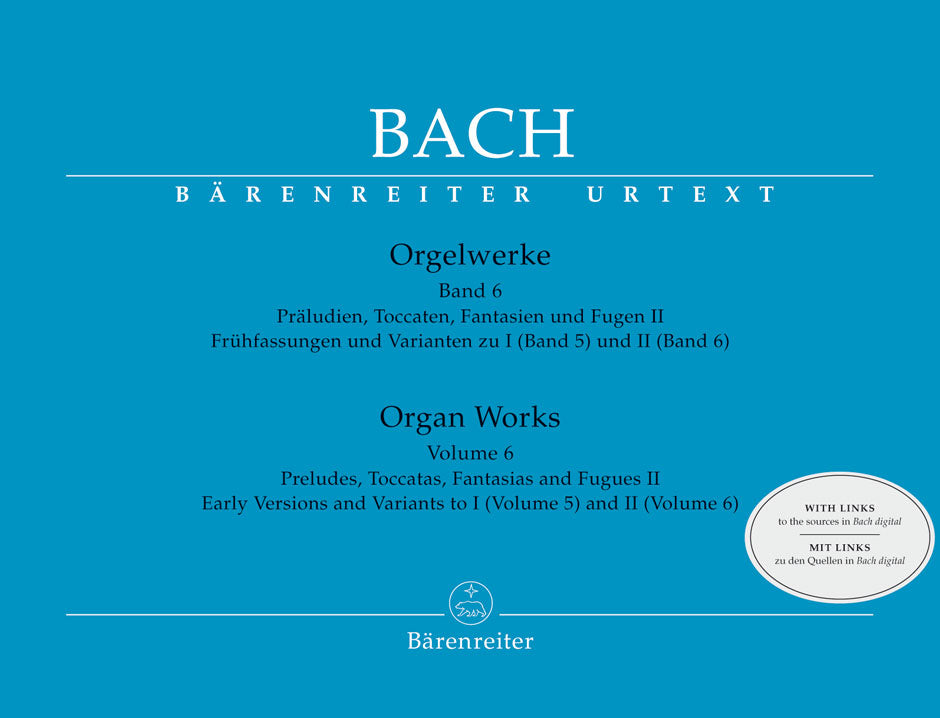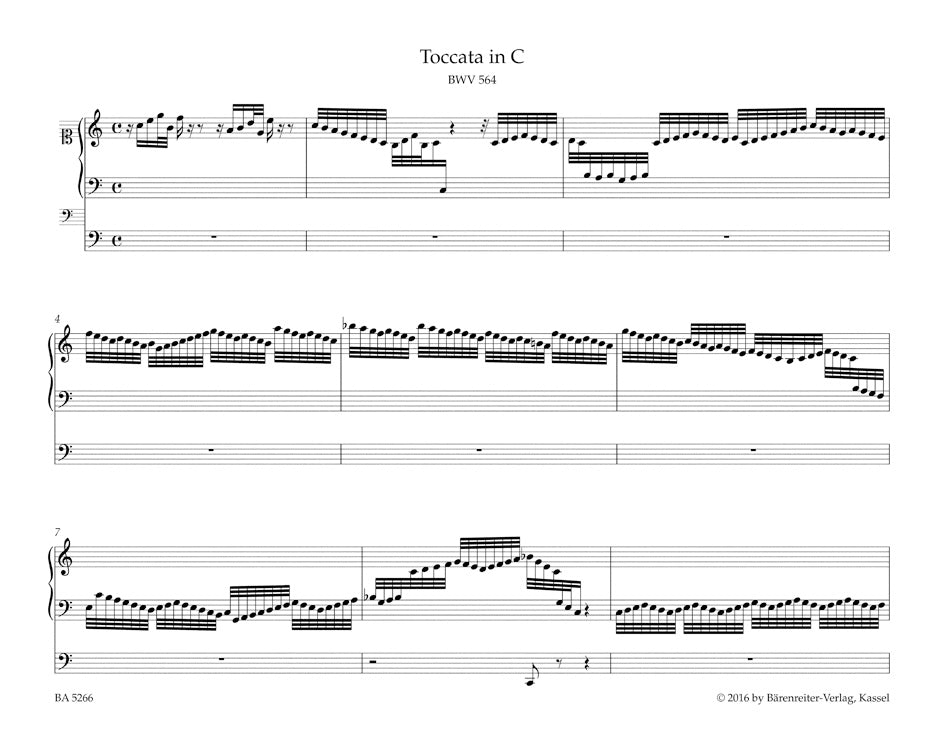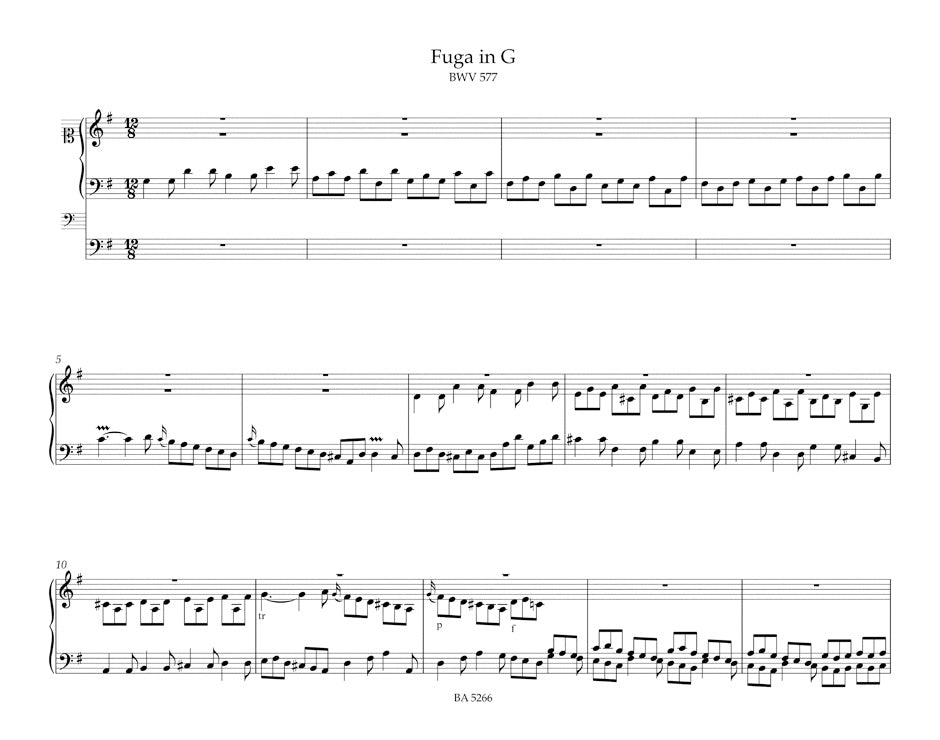Bach: Organ Works - Volume 6
Preludes, Toccatas, Fantasias and Fugues - Part II
In stock and typically ships within 1 business day.
- Composer: Johann Sebastian Bach (1685-1750)
- Editors: Dietrich Kilian, Peter Wollny
- Instrumentation (this edition): Organ
- Originally for: Organ, Keyboard
- ISMN:
- Size: 12.0 x 9.4 inches
- Pages: 136
- Urtext / Critical Edition
Description
The present volume is an updated edition of Series IV - Volume 6 of the "New Bach Edition" (NBA), prepared by Dietrich Kilian in 1964. The discovery of new sources and a reassessment of existing handwritten copies have brought about changes to the contents of the volume, which now includes the "Fantasia in C Minor" (BWV 1121), the "Fantasia in G Major" (BWV 571), the "Fugue in G Major" (BWV 577) and the C Major version of the "Toccata and Fugue in E Major" (BWV 566). On the other hand, the "Prelude in G Major" (BWV 568) as well as the alternative versions of the "Fugue in C Minor" (BWV 574a) and the "Prelude in A Major" (BWV 536a) have been discarded as presumably spurious.
Works:
- Toccata, Adagio and Fugue in C Major, BWV 564
- Fantasia in C Major, BWV 570
- Fantasy in C Minor, BWV 1121
- Fragment from Fantasy No. 6 in C Major, BWV 573
- Fugue on a theme by Legrenzi, BWV 574
- Fugue in C Minor, BWV 575
- Toccata and Fugue in D Minor, BWV 565
- Prelude & Fugue in C Major (Early Version), BWV 545a
- Toccata and Fugue in E Major, BWV 566
- Fugue on a Theme by Legrenzi (Early Version), BWV 574b
- Fugue in D Major (Early Version), BWV 532a
- Prelude in D Minor, BWV 549a
- Prelude and Fugue in E Minor, BWV 533a
- Prelude and Fugue in G Minor, BWV 553a
- Prelude in A Minor (Early Version), BWV 543a
- Fantasy in G Major, BWV 571
- Fugue in G Major, BWV 577
- "Little" Fugue in G Minor, BWV 578
- Prelude in A Minor, BWV 569
- Prelude and Fugue in A Minor, BWV 551
- Fantasy in C Major, BWV 563
- Fugue on a theme by Corelli, BWV 579
Publishers use a lot of words to describe what they sell, and we know it can be confusing. We've tried to be as clear as possible to make sure you get exactly what you are looking for. Below are descriptions of the terms that we use to describe the various formats that music often comes in.
Choral Score
A score for vocalists that only contains the vocal lines. The instrumental parts are not there for reference. Generally, cheaper than a vocal score and requires multiple copies for purchase.
Facsimile
Reproductions of the original hand-written scores from the composer.
Full Score
For ensemble music, this indicates that the edition contains all parts on a single system (there are not separate parts for each player). In larger ensembles, this is for the conductor.
Hardcover
Hardbound. Generally either linen-covered or half-leather.
Orchestral Parts
Similar to a wind set, this is a collection of parts. In the case of strings, the numbers listed are the number of copies included, though generally these are available individually (often with minimum quantities required).
Paperback
When publishers offer multiple bindings (e.g. hardcover) or study scores, this is the "standard" version. If you're planning to play the music, this is probably what you want.
Performance / Playing Score
A score of the music containing all parts on one system, intended for players to share. There are not separate parts for each player.
Set of Parts
For ensemble music, this indicates that there are separate individual parts for each player.
Solo Part with Piano Reduction
For solo pieces with orchestra, this is a version that contains a piano reduction of the orchestra parts. For piano pieces, two copies are typically needed for performance.
Study Score
A small (think choral size) copy of the complete score meant for studying, and not playing. They make great add-ons when learning concertos and small chamber works.
Vocal Score
A score prepared for vocalists that includes the piano/organ part or a reduction of the instrumental parts.
Wind Set
For orchestral music, this is a collection of wind and percussion parts. The specific quantities of each instrument are notated.
With Audio
In addition to the printed music, the edition contains recordings of the pieces. This may be an included CD, or access to files on the internet.
With / Without Fingering (Markings)
Some publishers prepare two copies - a pure Urtext edition that includes no fingering (or bowing) suggestions and a lightly edited version that includes a minimal number of editorial markings.





